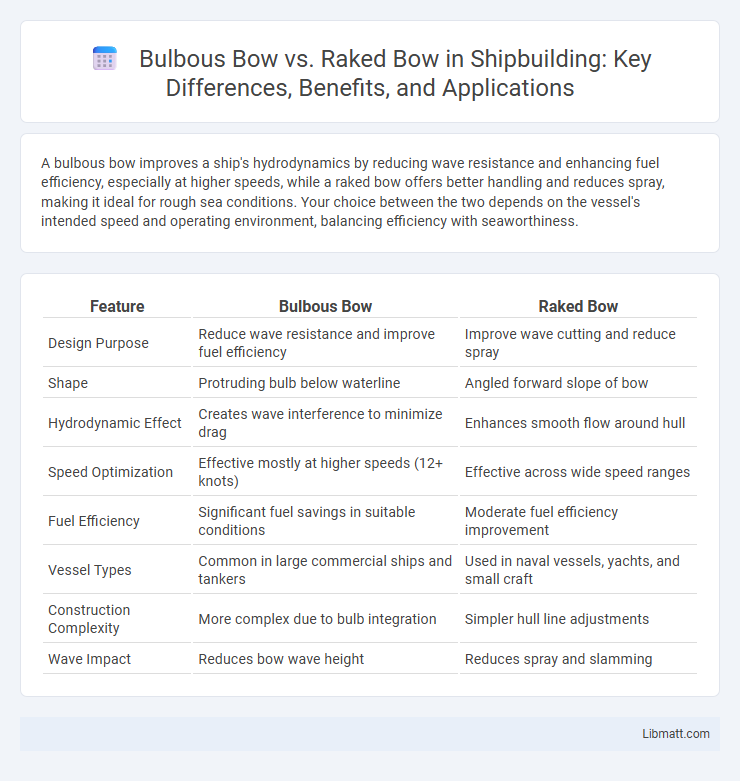A bulbous bow improves a ship's hydrodynamics by reducing wave resistance and enhancing fuel efficiency, especially at higher speeds, while a raked bow offers better handling and reduces spray, making it ideal for rough sea conditions. Your choice between the two depends on the vessel's intended speed and operating environment, balancing efficiency with seaworthiness.
Table of Comparison
| Feature | Bulbous Bow | Raked Bow |
|---|---|---|
| Design Purpose | Reduce wave resistance and improve fuel efficiency | Improve wave cutting and reduce spray |
| Shape | Protruding bulb below waterline | Angled forward slope of bow |
| Hydrodynamic Effect | Creates wave interference to minimize drag | Enhances smooth flow around hull |
| Speed Optimization | Effective mostly at higher speeds (12+ knots) | Effective across wide speed ranges |
| Fuel Efficiency | Significant fuel savings in suitable conditions | Moderate fuel efficiency improvement |
| Vessel Types | Common in large commercial ships and tankers | Used in naval vessels, yachts, and small craft |
| Construction Complexity | More complex due to bulb integration | Simpler hull line adjustments |
| Wave Impact | Reduces bow wave height | Reduces spray and slamming |
Introduction to Ship Bow Designs
Ship bow designs like the bulbous bow and raked bow significantly influence vessel performance and fuel efficiency. The bulbous bow features a protruding bulb below the waterline, reducing wave resistance and improving fuel economy, especially for large, ocean-going ships. The raked bow, angled backward, enhances wave piercing, offering better speed and maneuverability in rough seas, making it ideal for high-speed or smaller vessels.
Overview of Bulbous Bow
A bulbous bow is a protruding bulb at the front of a ship's hull just below the waterline, designed to reduce wave resistance and improve fuel efficiency by altering the flow of water around the hull. This hydrodynamic feature minimizes bow wave formation, resulting in decreased drag and enhanced speed, especially in large, fast-moving vessels such as cargo ships and cruise liners. Compared to a raked bow, which angles backward for slicing through water, the bulbous bow is primarily focused on energy-saving benefits during steady cruising conditions.
Overview of Raked Bow
The raked bow features a forward-leaning design that enhances a vessel's hydrodynamics by reducing water resistance and improving wave penetration. This bow style offers better efficiency at high speeds and increased agility, making it ideal for fast naval ships and racing yachts. Compared to bulbous bows, raked bows prioritize minimized weight and sharper angles to optimize performance in rough sea conditions.
Hydrodynamic Efficiency Comparison
Bulbous bows reduce wave resistance by creating a wave pattern that cancels out bow waves, enhancing hydrodynamic efficiency and fuel economy primarily in larger, faster vessels. Raked bows, characterized by their swept-back design, improve sea-keeping and reduce spray but offer less wave resistance reduction compared to bulbous bows. Choosing the right bow design impacts Your vessel's operational efficiency, with bulbous bows often preferred for maximum fuel savings on long voyages.
Performance at Different Speeds
Bulbous bows improve fuel efficiency and reduce wave resistance primarily at higher speeds, making them ideal for large vessels cruising steadily above 15 knots. Raked bows, in contrast, excel at cutting through waves in varying sea conditions, offering better performance and smoother ride at lower speeds and in rough waters. Your choice between a bulbous or raked bow depends on the vessel's typical operating speed and sea state conditions.
Impact on Fuel Consumption
Bulbous bows significantly reduce fuel consumption by altering water flow and decreasing wave resistance, especially at higher speeds. Raked bows enhance fuel efficiency through improved aerodynamics and smoother water displacement, primarily benefiting vessels operating at moderate speeds. Choosing between these bow designs depends on the vessel's speed profile and operational requirements to optimize fuel savings.
Maneuverability and Handling
Bulbous bows improve a vessel's stability and reduce wave resistance, enhancing fuel efficiency but can slightly decrease maneuverability in tight turns due to added underwater volume. Raked bows, with their sharp, angled design, offer superior handling and agility, allowing your ship to respond quickly in confined waters or rough sea conditions. Choosing between the two depends on prioritizing efficient straight-line cruising versus precise maneuvering capabilities.
Suitability for Various Vessel Types
Bulbous bows are ideal for large, slow-moving vessels such as cargo ships and tankers, enhancing fuel efficiency by reducing wave resistance at higher speeds. Raked bows suit fast vessels like naval ships and racing yachts, offering better wave-piercing capability and improved maneuverability in rough seas. Your choice depends on vessel speed and operational conditions, with bulbous bows favoring steady, economical cruising and raked bows prioritizing speed and agility.
Maintenance and Construction Considerations
Bulbous bows require more complex construction techniques and higher initial costs due to their specialized shape and integration with the hull, while raked bows are simpler and cheaper to build. Maintenance of bulbous bows involves regular inspection for damage and corrosion, particularly because they affect hydrodynamic performance, whereas raked bows have fewer maintenance challenges due to their straightforward design. Your choice between the two should consider long-term maintenance budgets and available shipyard capabilities.
Choosing Between Bulbous and Raked Bow Designs
Choosing between bulbous and raked bow designs depends on vessel speed, wave conditions, and fuel efficiency goals. Bulbous bows improve hydrodynamics by reducing wave resistance at higher speeds, ideal for large ships and tankers operating above 12 knots. Raked bows offer better sea-keeping and reduced spray for smaller vessels and yachts, enhancing performance in rough or variable conditions.
Bulbous bow vs raked bow Infographic

 libmatt.com
libmatt.com